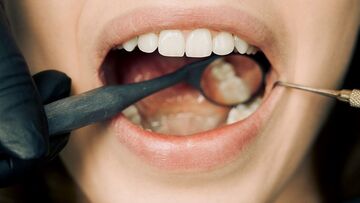
One of the most important yet often overlooked aspects of oral healthcare is flossing. NHS guidance states that we should all be flossing once a day from the age of 12, but only around 31% of UK adults actually do this.
There is often confusion around the tools and the technique. Poor experiences with flossing might lead you to avoid this step in the future. Bleeding gums is another common reason that individuals will avoid flossing – but this is also a clear sign that you really need to floss.
In this guide, we’re looking at the role of flossing in the everyday oral healthcare routine. We’ll also explain the tools available, how to use them, and where to turn for advice to make sure you’re getting it right.

Why is flossing important?
Cleaning your teeth twice a day is only one part of the oral health equation. When you brush your teeth, you actually miss a large section of your teeth. The area between your teeth makes up as much as 40% of the total surface area of your teeth.
So if you aren’t flossing, you could be only cleaning as much as 60% of your teeth. And if you have uneven or crooked teeth, you could be missing even more.
Flossing helps to remove food debris, plaque and tartar build up which can help to prevent staining, tooth decay and bad smells. In fact, if you haven’t flossed for a while, you might find that the first time you floss you’re met with a rather bad smell. This is because you are finally unearthing the bad smelling bacteria that is trapped between your teeth.

Choosing the right tools for flossing
There are many different tools available to help you floss your teeth effectively. You might need to use multiple tools to treat different areas in your mouth. If you’re unsure which tools are right for you, speak to your dental hygienist or dentist.
Dental floss
The most popular tool for flossing your teeth is dental floss. This is available in many different forms. It is most commonly sold as spools of waxed string that is fine enough to fit between your teeth. It could also have a minty-flavoured coating.
Dental floss is also available as floss tape which is thinner and flatter. This can be better for first-time flossers, as it’s less likely to irritate your gums. And finally, you can also buy floss harps, which have a piece of floss suspended on a small plastic holder which makes it easier to reach your teeth.

Interdental brushes
For larger gaps in your teeth, your dentist might recommend interdental brushes. These are small brushes available in different sizes. The small wire brush can be pushed between the teeth to effectively clean the area. These are also effective for cleaning around dental restorations such as bridges and dental implants.
Water flossers
Water flossers offer a gentle way to remove food debris from your teeth. These shoot a jet of water between your teeth to dislodge any food debris. They may also be effective for removing plaque and tartar. These are also effective for cleaning around dental restorations like veneers.
How do you know if you’re flossing correctly?
If you haven’t flossed before or you haven’t flossed for a very long time, it’s a good idea to visit your dental hygienist for a crash course. This will help you to gather the right tools for your teeth and make sure that you know how to use them. Book an appointment today to learn more about how to floss your way to better oral health.
Contact us to make an appointment
Exclusive Offer
Airflow stain removal from our hygienist


Top Dental Hygiene Questions Answered
13.03.2024

Top 6 Embarrassing Oral Health Problems
03.01.2024

Top dental hygiene questions answered
09.07.2019
Time for you perfect smile?
Book your consultation today
When visiting our practice you know you are visiting the dental professionals trained to the highest standards. You are greeted by our welcoming staff, who share the same aim, to make your visit with us as comfortable and stress free as possible.




